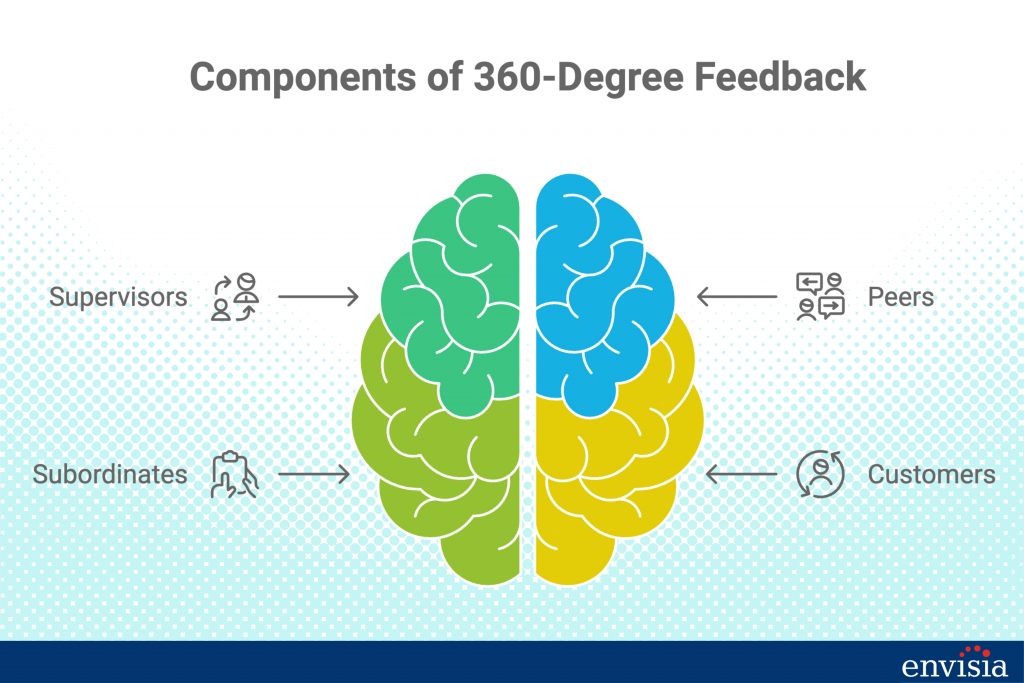The central feature of a 360-degree feedback system is its multi-source feedback mechanism, which collects input from a variety of stakeholders—including supervisors, peers, subordinates, and sometimes even customers. This comprehensive approach provides a holistic view of an individual’s performance, capturing diverse perspectives that a single-source evaluation might miss.
By integrating feedback from all directions within the organization, employees gain a balanced understanding of their strengths and areas for improvement, fostering greater self-awareness and promoting personal and professional growth.
Key Takeaways
- The central feature of a 360-degree feedback system is its multi-source feedback, providing a holistic view of an individual’s performance.
- Diverse feedback from supervisors, peers, and direct reports offers actionable feedback for personal and professional growth.
- Implementing best practices, such as ensuring confidentiality and using feedback as a development tool, maximizes the benefits of the 360-degree feedback process.

Understanding the 360-Degree Feedback System
A 360-degree feedback system is a performance appraisal method where employees receive confidential, constructive feedback from multiple sources. These sources often include supervisors, peers, subordinates, and even customers, providing a comprehensive view of the employee’s competencies and behaviors within the organizational context. Unlike traditional feedback that comes solely from a supervisor, this multi-source feedback tool ensures that feedback is balanced and reflects various perspectives, making it a critical component of the 360 assessment.
The key components of the feedback process involve collecting feedback data from all raters involved in the feedback process. This typically includes self-assessment, allowing employees to compare their self-perceptions with how others view them. By involving multiple raters, the system reduces biases and offers a more objective assessment of an individual’s performance, as well as subjective measures that can inform development. The 360 degree feedback system thus serves as both a performance management and a development tool, helping employees understand their strengths and areas for improvement.
The Central Feature: Diverse, Multi-Source Feedback

Feedback from All Directions
One of the key strengths of the 360 degree feedback system is its ability to gather input from all directions within the organization. Employees receive feedback from supervisors, peers, and direct reports, offering multiple perspectives on their competencies and behaviors. This multi-rater feedback ensures that the assessment is not skewed by the viewpoint of a single rater, providing a more balanced and fair evaluation.
By involving various stakeholders, the system captures a comprehensive picture of an employee’s performance, allowing for wide-ranging feedback that informs development. This holistic approach allows individuals to understand how their actions impact different levels of the organization, fostering greater self-awareness and encouraging positive behavioral changes.
Objective and Constructive Feedback
By collecting input from various sources, the 360-degree feedback system minimizes personal biases and provides more objective and constructive feedback. Diverse feedback enhances personal development by highlighting both strengths and weaknesses across different contexts. This comprehensive assessment allows employees to see patterns in their behavior that might not be evident through traditional feedback.
While subjective measures have their place, the 360-degree system combines them with measurable outcomes to provide actionable insights. This balanced approach helps employees create effective development plans based on feedback, focusing on specific areas for improvement. By understanding these nuances, individuals can take concrete steps to enhance their performance and contribute more effectively to the organization.
Best Practices in Implementing 360-Degree Feedback

Creating a Safe and Confidential Environment
For the 360 review system to be effective, it’s crucial to establish a safe and confidential environment. Ensuring confidentiality and anonymity encourages raters to provide honest and constructive feedback without fear of retribution. This trust in the process is a best practice that leads to more accurate and actionable feedback data.
Organizations should communicate clearly about how the feedback will be used and assure participants that individual responses will remain confidential. By fostering this safe space, employees are more likely to engage fully in the process, leading to more meaningful insights and positive outcomes.
Feedback as a Development Tool
Utilizing the 360 feedback system as a development tool rather than merely a performance review shifts the focus from evaluation to growth. This approach emphasizes learning and development, enabling employees to create actionable development plans based on the feedback received. By concentrating on measurable outcomes for improvement, individuals can track their progress and see tangible results over time.
This focus on personal and professional growth also contributes to leadership development and talent management within the organization, as well as the ultimate guide to 360-degree feedback. When employees understand their strengths and areas for development, they are better equipped to enhance their performance and contribute to the organization’s success.

Conclusion
In summary, the central feature of a 360-degree review system—the collection of diverse, multi-source feedback—provides invaluable insights into an individual’s performance. By receiving feedback from supervisors, peers, subordinates, and other stakeholders, employees gain a holistic view of their strengths and areas for improvement, leading to easily measurable performance outcomes. This comprehensive approach not only enhances self-awareness but also fosters personal and professional growth.
